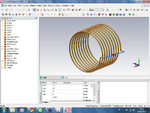MrElec
Advanced Member level 4
Hi,
I've simulated an Air Core Coil with CST MWS and i want to get its characteristics L inductance and Q quality factor by using S-parameters from full-wave simulation,knowing that my frequency range extends from 10 MHz to 1000 MHz.
I've simulated an Air Core Coil with CST MWS and i want to get its characteristics L inductance and Q quality factor by using S-parameters from full-wave simulation,knowing that my frequency range extends from 10 MHz to 1000 MHz.


